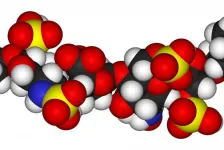(Press-News.org) PHILADELPHIA--Even before the COVID-19 pandemic, mental health issues have been on the rise across the nation, but many struggle to access the care they need. Collaborative care--a proven approach for improving psychiatric care--combats this issue by integrating mental health professionals into the primary care setting. Penn Medicine's collaborative care program, Penn Integrated Care (PIC), utilizes a centralized resource center to facilitate intake, triage, and referral management for all patients with mental health needs. A new study, published today in the Annals of Family Medicine, suggests that this approach is effective and efficient for meeting the needs of a diverse group of patients with the full range of mental health conditions seen in primary care.
"Collaborative care is a proven model for connecting both physical and mental health, which is what modern healthcare is all about. Without a formalized process for following up with patients and providing supportive guidance, individuals in need of mental health care may fall through the cracks or receive suboptimal care," said corresponding author Courtney Benjamin Wolk, PhD, an assistant professor of Psychiatry in the Perelman School of Medicine at the University of Pennsylvania.
In January 2018, Penn's department of Psychiatry and the Primary Care Service Line launched PIC to increase access to and engagement with mental health care to improve mental and physical health outcomes. In the PIC model, which builds upon other collaborative care programs, the collaborative care team consists of the patient, primary care provider (PCP), a mental health provider, consulting psychiatrist, and the mental health intake coordinators in the Resource Center.
Penn Medicine, a large and diverse health system, encouraged primary care practitioners to refer patients with any mental health symptom or condition for further evaluation, as opposed to only those patients with mild to moderate issues, as is the case in typical collaborative care models. The Resource Center assesses patients by phone, referring them to the appropriate level of care using decision-support software, and facilitating engagement in community-based specialty care. Previous analyses and research demonstrates the benefit of collaborative care for patients with depression or anxiety, however this is the first large study illustrating the benefits of adding a resource center to the model.
"The benefit of this collaborative care model with a resource center is two-fold. First, while other care models support mild-to-moderate mental health conditions, PCPs face the full spectrum of conditions and are often challenged to access appropriate care for more severe conditions--the PIC approach ensures these patients who need more specialized care are supported as well," Wolk said. "Second, the Resource Center alleviates the mental health professionals in the practices from becoming overwhelmed with assessment and referral activities given their limited time. This allows the mental health providers to use their time to see and treat patients, after they are evaluated through the Resource center."
Primary care providers in eight practices participating in PIC referred patients with any unmet mental health needs to the program. In first 12 months, 6,124 patients were referred. These individuals reported symptoms consistent with a range of conditions from mild to moderate depression and anxiety to serious mental illness including psychosis and acute suicidal ideation. Of those who then enrolled in PIC, the average length of treatment was 7.2 encounters over 78.1 days. Nearly 33 percent of patients with depression and almost 40 percent of patients with anxiety experienced symptom remission, over the first year of PIC. In the subsequent years since the launch of PIC, even more patients have experienced remission.
The researchers gathered feedback on PIC from stakeholders, including health system leaders, PCPs, mental health personnel, and patients, and all viewed the program favorably. Stakeholders found that PIC took the onus of navigating community mental health treatment off the shoulders of providers and patients, and created a streamlined referral process that enabled more patients to access needed care. Furthermore, stakeholders reported during qualitative interviews that they found PIC to be an efficient and cost-effective way to coordinate and risk-stratify primary care patients' mental health needs when compared to services as usual.
Of the eight practices which initially implemented PIC in 2018, all eight continue to implement the program, demonstrating 100 percent sustainment. Additionally, due to the program's success, expansion is in progress--PIC has recently expanded to three new primary care practices, and 10-15 are expected in the next year.
"The results from the first year of PIC reinforce that collaborative care brings high-quality mental health care to patients in a way that is convenient, efficient, and effective. As we continue to expand our program across primary care at Penn Medicine, we hope other health systems and physician organizations look to collaborative care to meet their patients' mental health needs," said Matthew Press, MD, Physician Executive of Penn Primary Care.
INFORMATION:
Other Penn co-authors include Briana S. Last, Cecilia Livesey, Maria A. Oquendo, David S. Mandell, Erin Ingram, Anne C. Futterer, Grace P. Kinkler, and David W. Oslin.
Funding for this research project was supported by a Center for Therapeutic Effectiveness Research PCOR pilot grant, Penn's Center for Mental Health, Penn's Center for Health Incentives and Behavioral Economics, the National Institute of Mental Health (P50 MH113840), and the National Science Foundation Graduate Research Fellowship (DGE-1321851).
Penn Medicine is one of the world's leading academic medical centers, dedicated to the related missions of medical education, biomedical research, and excellence in patient care. Penn Medicine consists of the Raymond and Ruth Perelman School of Medicine at the University of Pennsylvania (founded in 1765 as the nation's first medical school) and the University of Pennsylvania Health System, which together form a $8.9 billion enterprise.
The Perelman School of Medicine has been ranked among the top medical schools in the United States for more than 20 years, according to U.S. News & World Report's survey of research-oriented medical schools. The School is consistently among the nation's top recipients of funding from the National Institutes of Health, with $496 million awarded in the 2020 fiscal year.
The University of Pennsylvania Health System's patient care facilities include: the Hospital of the University of Pennsylvania and Penn Presbyterian Medical Center--which are recognized as one of the nation's top "Honor Roll" hospitals by U.S. News & World Report--Chester County Hospital; Lancaster General Health; Penn Medicine Princeton Health; and Pennsylvania Hospital, the nation's first hospital, founded in 1751. Additional facilities and enterprises include Good Shepherd Penn Partners, Penn Medicine at Home, Lancaster Behavioral Health Hospital, and Princeton House Behavioral Health, among others.
Penn Medicine is powered by a talented and dedicated workforce of more than 44,000 people. The organization also has alliances with top community health systems across both Southeastern Pennsylvania and Southern New Jersey, creating more options for patients no matter where they live.
Penn Medicine is committed to improving lives and health through a variety of community-based programs and activities. In fiscal year 2020, Penn Medicine provided more than $563 million to benefit our community.
Juvenile white-tailed deer that strike out to find new home ranges -- despite facing more risks -- survive at about the same rate as those that stay home, according to a team of researchers who conducted the first mortality study of male and female dispersal where deer were exposed to threats such as hunting throughout their entire range.
Dispersal occurs when a juvenile leaves the area where it was born and moves to a new location where the young animal establishes its adult home range, explained Duane Diefenbach, Penn State adjunct professor of wildlife ecology. The instinctual dispersal of young deer from the area where they were born to a new home range protects the species' gene pool from inbreeding with close relatives.
Diefenbach's ...
Researchers have identified a critical mechanism that allows deadly bacteria to gain resistance to antibiotics.
The findings offer a potential new drug target in the search for effective new antibiotics as we face the growing threat of antimicrobial resistance (AMR) and infections caused by bacterial pathogens.
The study investigated quinolone antibiotics which are used to treat a range of bacterial infections, including TB (tuberculosis). Quinolones work by inhibiting bacterial enzymes, gyrase and topoisomerase IV, thereby preventing DNA replication and RNA synthesis essential to growth.
They are ...
Spectacular fossil plants preserved within a volcanic ash fall in China have shed light on an evolutionary race 300 million years ago, which was eventually won by the seed-bearing plants that dominate so much of the Earth today.
New research into fossils found at the 'Pompeii of prehistoric plants', in Wuda, Inner Mongolia, reveals that the plants, called Noeggerathiales, were highly-evolved members of the lineage from which came seed plants.
Noeggerathiales were important peat-forming plants that lived around 325 to 251 million years ago. Understanding their relationships to other plant groups ...
TROY, N.Y. -- Using a nanopore, researchers have demonstrated the potential to reduce the time required for sequencing a glycosaminoglycan -- a class of long chain-linked sugar molecules as important to our biology as DNA -- from years to minutes.
As published this week in the Proceedings of the National Academies of Sciences, a team from Rensselaer Polytechnic Institute showed that machine-learning and image recognition software could be used to quickly and accurately identify sugar chains -- specifically, four synthetic heparan sulfates -- based on the electrical signals generated as they passed through a tiny hole in a crystal wafer.
"Glycosaminoglycans are a complex repertoire of sequences, ...
An international team of scientists have explained how legume trees are key in liberating minerals locked in iron minerals and the benefits are passed on to nearby trees
The research shows that the trees are able to alter their soils microbiome in a way that increases access to nutrients and supports growth
The findings provide new insight into the role of these trees in safeguarding the function of tropical forests and sustainable reforestation
Researchers have found that nitrogen-fixing legume trees can support themselves and surrounding trees not only with increased access to nitrogen, but with other key nutrients through enhanced mineral weathering.
The team, led by the University ...
In the United States, one in 10 babies are born too soon, resulting in complications that can affect their locomotor development and influence such simple tasks as balance, walking and standing later in life. A new peer-reviewed study by Children's National Hospital, published in the Proceedings of the National Academy of Sciences of the United States of America (PNAS), explores exactly what neural circuitry of the cerebellum is affected due to complications that occur around the time of birth causing these learning deficits, and finds a specific type of neurons -- Purkinje cells -- to play a central role.
Up until now, there has been a sparsity of techniques available to measure neuronal ...
American adults without a college degree have experienced greater reductions in life expectancy when compared to their more-educated counterparts, USC and Princeton researchers have found.
The study reveals that after nearly a century of declining mortality up to the late 1990s, the progress continued into the 21st century for more-educated Americans but stalled for the population as a whole and reversed for the two-thirds of Americans who do not have a college degree.
The study appeared Monday in the Proceedings of the National Academy of Sciences.
The ...
Malaria is the deadliest pathogen in human history. Nearly half the people on Earth are at risk of contracting the disease from the parasites that cause it. But humans aren't the only ones who can get these parasites--different forms are found in other animals, including birds. By studying the DNA of those strains, scientists can get a better picture of how malarial parasites live, which may give clues on how to stop the disease. In a new paper in PNAS, researchers analyzed blood samples of more than 1,000 species of birds from the Andes looking for malaria; they found that the strains of malaria present in a local area don't always neatly align with the types of birds living there.
"Traditionally, we thought that there's ...
(Boston)--Despite the positive advances that anti-human immunodeficiency virus (HIV) therapy, commonly called anti-retroviral therapy (ART) or highly active antiretroviral therapy (HAART), has had on the life expectancy of HIV-positive people, finding a cure for HIV or acquired immunodeficiency syndrome (AIDS) has remained elusive.
"One of the major challenges in curing HIV is that there is a persistent latent reservoir of virus that is not targeted by current antiretroviral treatments and is hidden from immune cells. When treatment is interrupted, this reservoir of the virus allows the HIV ...
Here is a link to a free Altmetric Report on this Research Output
Aging-US published "Hyperbaric oxygen therapy increases telomere length and decreases immunosenescence in isolated blood cells: a prospective trial" which reported that the aim of the current study was to evaluate whether hyperbaric oxygen therapy (HBOT) affects telomere length (TL) and senescent cell concentrations in a normal, non-pathological, aging adult population.
Thirty-five healthy independently living adults, aged 64 and older, were enrolled to receive 60 daily HBOT exposures.
Whole blood samples were collected at baseline, at the 30th and 60th session, and 1-2 weeks following the last HBOT session.
Telomeres length of T helper, T cytotoxic, natural killer and ...




